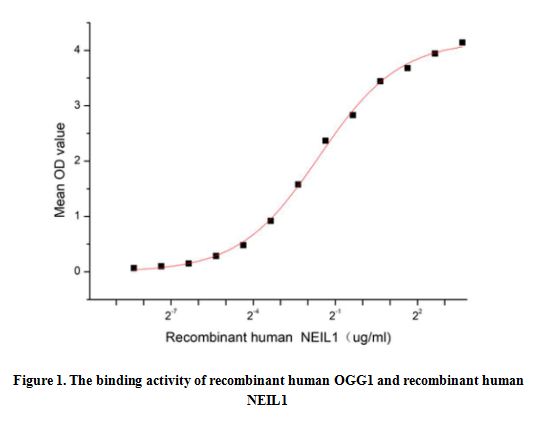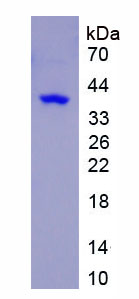Active Oxoguanine Glycosylase 1 (OGG1) 

HMMH; HOGG1; MUTM; OGH1; 8-Oxoguanine DNA Glycosylase; DNA-(apurinic or apyrimidinic site) lyase; N-glycosylase/DNA lyase
- UOM
- FOB US$ 248.00 US$ 620.00 US$ 1,240.00 US$ 3,720.00 US$ 9,300.00
- Quantity
Overview
Properties
- Product No.APC704Hu01
- Organism SpeciesHomo sapiens (Human) Same name, Different species.
- ApplicationsCell culture; Activity Assays.
Research use only - DownloadInstruction Manual
- CategoryEnzyme & Kinase
- Buffer FormulationPBS, pH7.4, containing 0.01% SKL, 5% Trehalose.
- Traits Freeze-dried powder, Purity > 90%
- Isoelectric Point7.7
Sign into your account
Share a new citation as an author
Upload your experimental result
Review

Contact us
Please fill in the blank.
Activity test

Oxoguanine Glycosylase 1 (OGG1), a prominent member of the BER enzyme family, is an essential DNA repair enzyme. OGG1 is highly conserved across eukaryotic organisms and is expressed in various cell types. Its activity is regulated by several factors, including cellular redox status, DNA damage, and cell cycle progression. In addition to its role in repairing oxidative DNA damage, OGG1 has also been implicated in other cellular processes, such as transcription, replication, and apoptosis. In addition, the combination of OGG1 and NEIL1 can contribute to improve the repair efficiency of oxidative DNA damage, maintain genomic stability, and reduce the risk of cell mutation. Thus a functional binding ELISA assay was conducted to detect the interaction of recombinant human OGG1 and recombinant human NEIL1. Briefly, biotin-linked OGG1 were diluted serially in PBS, with 0.01% BSA (pH 7.4). Duplicate samples of 100 ul were then transferred to NEIL1-coated microtiter wells and incubated for 1h at 37℃. Wells were washed with PBST 3 times and incubation with Streptavidin-HRP for 30min, then wells were aspirated and washed 5 times. With the addition of substrate solution, wells were incubated 15-25 minutes at 37℃. Finally, add 50 µl stop solution to the wells and read at 450 nm immediately. The binding activity of recombinant human OGG1 and recombinant human NEIL1 was shown in Figure 1, the EC50 for this effect is 0.33 ug/mL.
Usage
Reconstitute in 10mM PBS (pH7.4) to a concentration of 0.1-1.0 mg/mL. Do not vortex.
Storage
Avoid repeated freeze/thaw cycles. Store at 2-8°C for one month. Aliquot and store at -80°C for 12 months.
Stability
The thermal stability is described by the loss rate. The loss rate was determined by accelerated thermal degradation test, that is, incubate the protein at 37°C for 48h, and no obvious degradation and precipitation were observed. The loss rate is less than 5% within the expiration date under appropriate storage condition.
Increment services
-
 BCA Protein Quantification Kit
BCA Protein Quantification Kit
-
 Molecular Mass Marker for Protein
Molecular Mass Marker for Protein
-
 Monoclonal Antibody Customized Service
Monoclonal Antibody Customized Service
-
 Polyclonal Antibody Customized Service
Polyclonal Antibody Customized Service
-
 Protein Activity Test Experiment Service
Protein Activity Test Experiment Service
-
 Electrophoretic Mobility Shift Assay (EMSA) Experiment Service
Electrophoretic Mobility Shift Assay (EMSA) Experiment Service
-
 Buffer
Buffer
-
 Lentivirus Packaging Experiment Service
Lentivirus Packaging Experiment Service
-
 Adenovirus Packaging Experiment Service
Adenovirus Packaging Experiment Service
-
 Real Time PCR Experimental Service
Real Time PCR Experimental Service
-
 Spike RBD Protein (S-RBD)
Spike RBD Protein (S-RBD)
-
 Protein G
Protein G
-
 Protein A
Protein A
Citations
- The levels of 7,8-dihydrodeoxyguanosine (8-oxoG) and 8-oxoguanine DNAglycosylase 1 (OGG1) - A potential diagnostic biomarkers of Alzheimer'sdisease.pubmed:27538622
- Expression Pattern of MALAT-1 Gene and Oxidative DNA Damage in Nigeria Men with Prostate Carcinoma.







